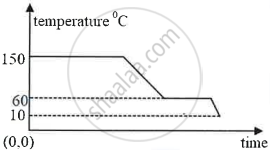Advertisements
Advertisements
प्रश्न
The S.I. unit of specific latent heat is ______.
विकल्प
cal g-1
cal g-1 K-1
J kg-1
J kg -1 K-1
उत्तर
The S.I. unit of specific latent heat is J kg-1.
APPEARS IN
संबंधित प्रश्न
1 g ice of 0℃ melts to form 1 g water at 0℃. State whether the latent heat is absorbed or given out by ice.
Which has more heat: 1 g ice at 0℃ or 1g water 0℃? Give reason.
Water expands on reducing its temperature below ______°C.
What is the name given to the energy absorbed during a phase change?
Name two factors on which the heat absorbed or given out by a body depends.
What happens to the heat supplied to a substance when the heat supplied causes no change in the temperature of the substance?
Give one consequence of the high specific latent heat of fusion of ice.
Why do we feel much comfortable when we sit under a moving fan especially when our body is sweating?
Explain, why no tracks are left on the ice during ice skating?
What observation you will record and how will you determine the specific latent heat of fusion of ice?
Steam at 100°C is passed over 1000 g of ice at 0°C. After some time, 600 g of ice at 0°C is left and 450 g of water at 0°C is formed. Calculate the specific latent heat of vaporization of steam (Given: specific heat capacity of water = 4200 J/kg°C, specific latent heat of fusion of ice = 336,000 J/kg.)
1 kg of water is contained in a 1.25 kW kettle. Assuming specific heat capacity of water = 4.2 J/g °C and specific latent heat of vaporization = 2260 J/g, calculate:
(i) the time taken for the temperature of water to rise from 25°C to its boiling point,
(ii) the mass of water which evaporates per minute from the boiling water.
The latent heat of vaporisation is a term referred for the conversion of gas into liquid.
During reheating, ice is converted to water at a temperature of 0 °C.
1 kg of dry air at a temperature of 40 °C can hold a maximum of 49 g of water vapour.
For the same mass of ice and ice-cold water, why does ice produce more cooling than ice-cold water?
Who introduced the term latent heat?
The diagram below shows a cooling curve for a substance:

- State the temperatures at which the substance condenses.
- The temperature range in which the substance is in liquid state.
- Why do we prefer ice to ice-cold water for cooling a drink?
